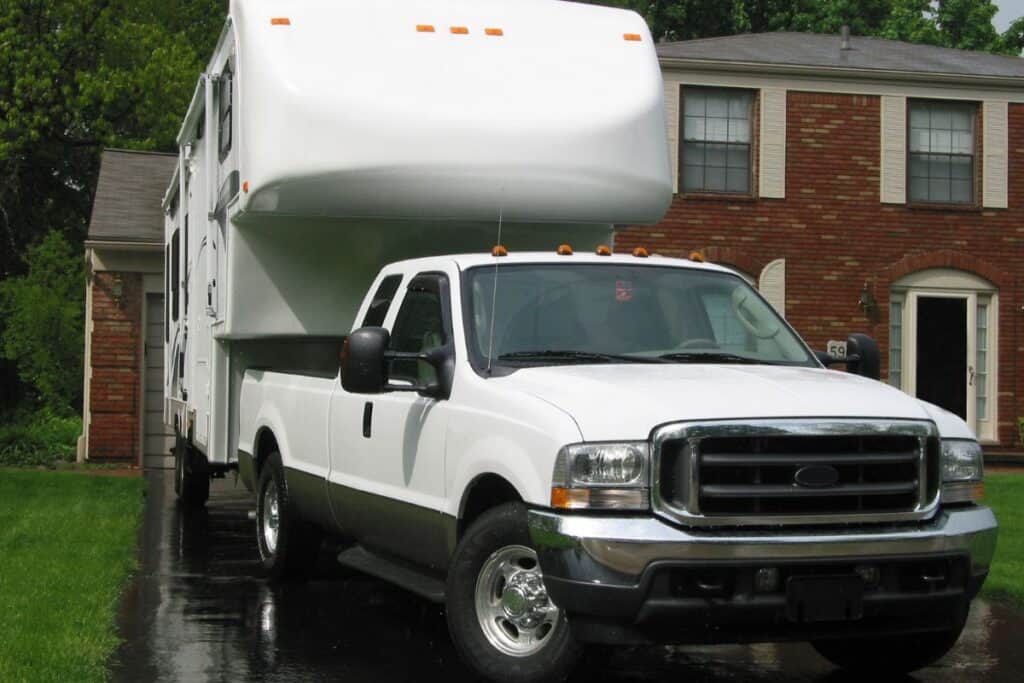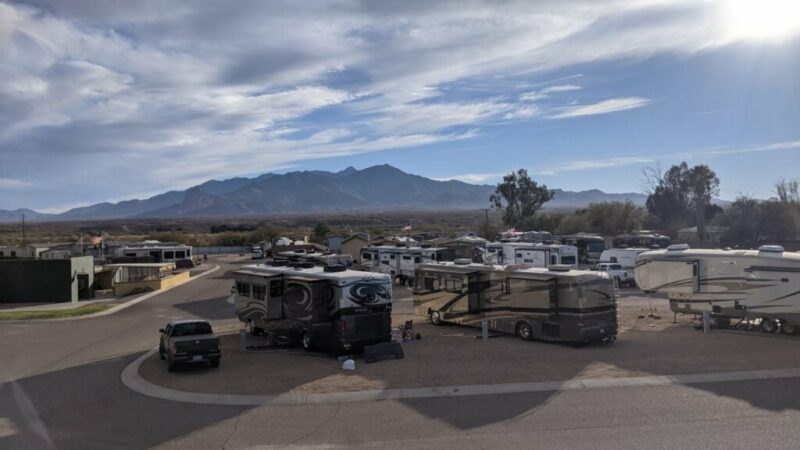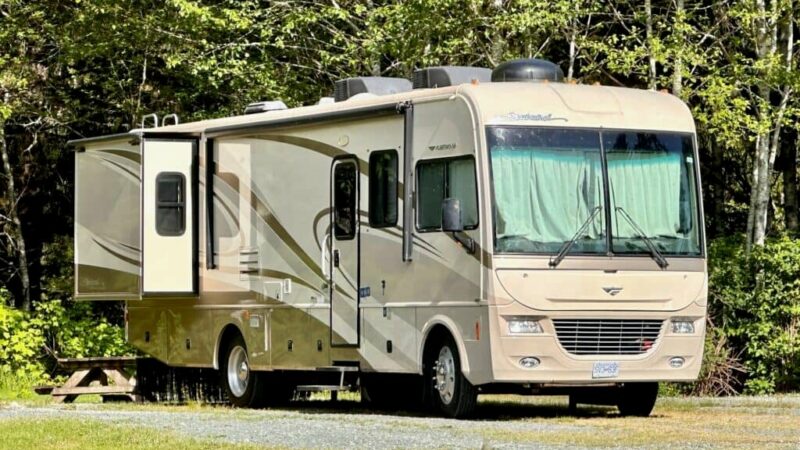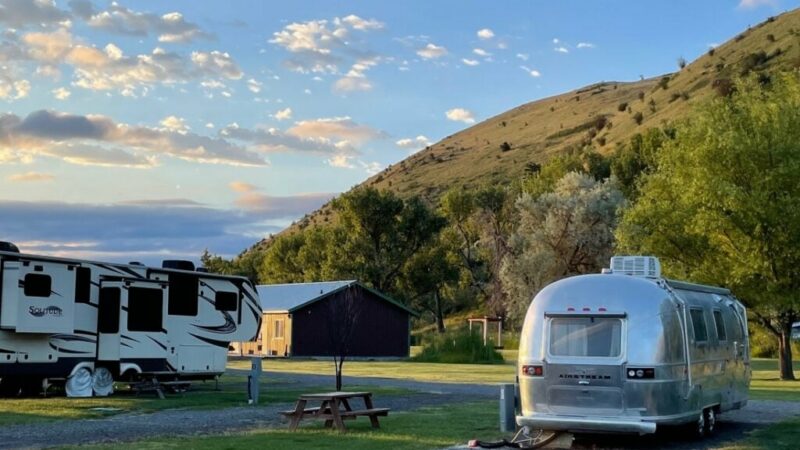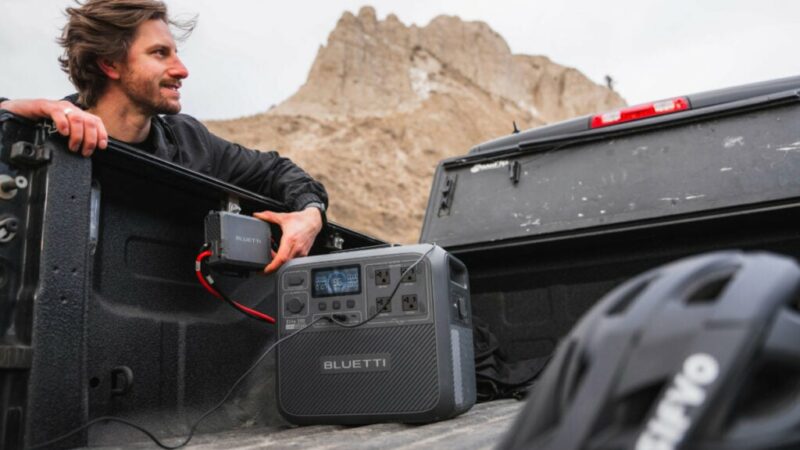Mastering the Art of Backing Up a Trailer
Backing up a travel trailer or a 5th wheel trailer can be daunting for new and experienced RVers alike. The good news is that with some practice and the right techniques, anyone can become proficient.
This article will cover essential tips and tricks to make backing up your travel trailer or 5th-wheel trailer a breeze.
Travel Trailer Versus Fifth-wheel
Before diving into techniques, it’s crucial to understand the difference between a travel trailer and a fifth-wheel.
Travel trailers attached to the bumper hitch of the tow vehicle, making the pivot point the rear bumper of the tow vehicle. Small adjustments in the steering wheel will be required as the trailer reacts quickly.
Fifth-wheel trailers connect to a hitch in the bed of a truck, creating a pivot point in the middle of the truck bed. This could be a difference of 4 feet, which is a lot when it comes to backing up a trailer. Fifth-wheels require more turning action of the steering wheel.
These differences affect how each trailer responds when backing up. Preparation is key so regardless of which type of trailer you have you need to start with these three essential steps.
- Check Your Surroundings: Ensure the area behind you is clear of obstacles. Look for any potential hazards.
- Adjust Your Mirrors: Properly adjust your side mirrors to have a clear view down the sides of your trailer. Towing mirrors can be a great help if you don’t have them.
- Use a Spotter: If possible, have someone outside the vehicle guide you. Establish clear hand signals beforehand.
Step-by-Step Guide to Backing Up a Travel Trailer
Okay, take a deep breath, grip the steering wheel, and let’s get that trailer backed into your campsite.
- Find Your Pivot Point: Identify the point where your trailer will pivot. For a travel trailer, this is near the rear of the tow vehicle.
- Tight Turns: For tight turns, watch your trailer tires and back up until they are about at the point you need to turn. This could be the edge of your campsite. Make your hard cut at this point.
- Start with Small Adjustments: Small steering inputs are more effective. Avoid oversteering.
- Steer, Then Gear: Turning while moving is part of backing a trailer; however, when you can, turn your steering wheel to adjust and then reverse.
- Use the “S” Method: If you have room, start by pulling forward to the right, then turn the wheel left to begin backing up. This creates an “S” shape and helps align the trailer.
- Watch Your Mirrors: Keep an eye on both side mirrors. If the trailer is veering too far to one side, adjust accordingly.
- Slow and Steady: Take your time. There’s no need to rush. Slow movements prevent sudden changes in direction.
- Another good practice while backing a travel trailer is to begin by holding your hands at the 6 o’clock position on the steering wheel. By doing this, the trailer will maneuver in the direction you turn the wheel.
Step-by-Step Guide to Backing Up a Fifth-Wheel Trailer
The general consensus is that fifth-wheels are easier to tow than travel trailers. They are more stable with less sway going forward down the road. The backing process isn’t necessarily easier or harder it’s just different.
- Understand the Pivot Point: The pivot point is closer to the truck’s rear axle, providing a different response than a travel trailer.
- Reaction Time: 5th wheels react slower to steering input when backing.
- Get the Angle Right: Angle the truck and trailer correctly before backing up. This often requires a wider turn.
- Use the “Z” Method: Unlike the “S” method for travel trailers, the “Z” method starts with turning the wheel right and then left, creating a smoother backing process.
- Rely on Mirrors and Camera: If your truck has a backup camera, use it in conjunction with your mirrors for a comprehensive view.
- Practice Patience: Like with travel trailers, slow and steady movements are crucial.
Common Challenges and How to Overcome Them
Every campground is different and unexpected obstacles may be present. For these reasons, each backing experience will be a little different.
And campsites aren’t the only time you will need to use your backing skills. What if you get in a tight spot at a gas station or find yourself in a cramped residential area
Backing a trailer will come with challenges that can be stressful. The last thing you want to do is add to the problem so it’s important to be aware of some common issues.
Trailer Drift
One thing that newbies find hard is turning the steering wheel in the opposite direction than they’re used to when backing a trailer. We’ve all been there, you turn the wheel and start moving just to see your trailer in the mirror doing the exact opposite of what you wanted it to do.
If your trailer starts drifting to one side, the correction is simply steering in the opposite direction slowly. Slowly being the keyword. When this happens, stop and adjust the wheel and then proceed.
Oversteering
Avoid large steering adjustments. Small, incremental changes are more effective. We are used to backing with no trailer where it’s easy to quickly spin the steering wheel in either direction to make fast adjustments.
It can be frustrating to watch experienced drivers effortlessly in one continues motion slip a trailer into a spot. This will come with time; however, slow and steady is key when learning.
Focus on one thing at a time. Are you reversing, adjusting the wheel, or thinking about what you need to do in that moment? While learning you should be only doing one of these things at a time.
Blind Spots
Everyone has a favorite side to back into. For most people, it will be the driver’s side as you have a clear view out your window. Regardless of which side you are on you will need to use your mirrors and having help is always best.
Use your spotter and mirrors to keep an eye on blind spots. Always double-check before making a move. You should never be in a situation where you have to assume you are clear to backup.
Safe Towing Practices

Towing a trailer is a big responsibility that can’t be taken lightly. You are putting yourself and others in danger if you are not competent in your abilities on the road. Safe towing practices must be followed.
Any responsible driver towing a trailer must first ensure they are staying within their limits. Just because you can walk into a dealer and leave with a 45-foot fifth-wheel doesn’t mean you are doing so safely.
Just as you have limits, so do your tow vehicle and trailer. Always stay within legal weight limits for tow vehicles and trailers and ensure both are in good working order. Pre-trip checks are a must!
This one might be getting worn out but always use a spotter. Having a second and even third set of eyes is critical. The driver has a lot going on and can always use help.
Conclusion
Backing a trailer for the first time with onlookers and a vehicle waiting behind you is not gonna be a good experience. Practice makes perfect so find an empty parking lot to practice. The more you practice, the more confident you’ll become.
You will become more familiar with both your tow vehicle and trailer over time. You will be able to identify reference points to help guide your trailer into position.
Most vehicles now come with backup cameras and we have become reliant on them. Consider adding a backup camera or trailer assist system to your setup. These tools can provide extra guidance. Always use mirrors and spotters first and cameras for extra assistance.
Whether you’re a seasoned RVer or new to the lifestyle, mastering this skill will make your travels smoother and more enjoyable. By following these tips and maintaining a calm, patient approach, you’ll soon find that backing up your trailer is no longer a daunting task.
The post Mastering the Art of Backing Up a Trailer appeared first on RV LIFE.
Source: https://rvlife.com/mastering-the-art-of-backing-up-a-trailer/

